Neuroprotective Effect of Natural Compounds in Paclitaxel-Induced Chronic Inflammatory Pain
Abstract
:1. Introduction
2. Material and Methods
2.1. Chemicals
2.2. Animals
2.3. Paclitaxel-Induced Neuropathic Pain
2.4. Thermal Pain Sensation
2.4.1. Latency of Falling
2.4.2. Body Weight Analysis
2.4.3. Pain Threshold (Mechanical Hypersensitivity)
2.5. Oxidative Stress Markers
2.6. Hematoxylin and Eosin Staining
2.7. Immuno-Histopathological Evaluation
2.8. ELISA
2.9. Western Blot Assay
2.10. Statistical Analysis
3. Results
3.1. Effect on Thermal Pain Sensation
3.2. Effect on the Latency of Falling
3.3. Effect on Changes in Body Weight
3.4. Effect on vonFrey-Induced Pain
3.5. Effect on Oxidative Stress Enzyme
3.6. H and E Staining Examination
3.7. IHC Analysis
3.8. Effects on Inflammatory Marker (ELISA)
3.9. Western Blot Findings
4. Discussion
5. Conclusions
Author Contributions
Funding
Institutional Review Board Statement
Informed Consent Statement
Data Availability Statement
Acknowledgments
Conflicts of Interest
Abbreviations
| Berbamine | (BBM) |
| Bergapten | (BRG) |
| Carveol | (CAR) |
| Paclitaxel | (PTX) |
| Glutathione | (GSH) |
| Glutathione S-transferase | (GST) |
| Inducible nitric oxide synthase | (iNOS) |
| Lipid peroxidase | (LPO) |
| Hematoxylin and eosin | (H and E) |
| Immunohistochemistry | (IHC) |
| Cyclooxygenase | (COX-2) |
| Tumor necrosis factor-alpha | (TNF-α) |
| Nuclear factor kappa B | (NF-κb) |
| Enzyme-linked immunosorbant assay | (Elisa) |
| Phosphate buffer saline | (PBS) |
| Hydrogen peroxide | (H2O2) |
| 5,5′-dithio-bis-2-nitrobenzoic acid | (DTNB) |
| 2,4-Dinitrochlorobenzene | (CDNB) |
| Diaminobenzidine peroxidase | (DAB) |
| Trichloroacetic acid | (TCA) |
| Research and ethical committee | (REC) |
| Intraperitoneally | (i.p) |
| Sciatic nerve | (SN) |
| Spinal cord | (SC) |
| Nitric oxide | (NO) |
| Horseradish peroxidase | (HRP) |
| Heat latency | (HL) |
| Falling | (LF) |
| Paw withdrawal threshold | (PWT) |
| Paclitaxel induced peripheral neuropathic pain | (PIPNP) |
| Chemotherapy-induced peripheral neuropathic pain | (CIPNP) |
| Toll-like receptors | (TLR) |
| Transient receptor potential | (TRP) |
References
- Postma, T.; Vermorken, J.; Liefting, A.; Pinedo, H.; Heimans, J. Paclitaxel-induced neuropathy. Ann. Oncol. 1995, 6, 489–494. [Google Scholar] [CrossRef] [PubMed]
- Zajączkowska, R.; Kocot-Kępska, M.; Leppert, W.; Wrzosek, A.; Mika, J.; Wordliczek, J. Mechanisms of chemotherapy-induced peripheral neuropathy. Int. J. Mol. Sci. 2019, 20, 1451. [Google Scholar] [CrossRef] [PubMed] [Green Version]
- Augusto, C.; Pietro, M.; Cinzia, M.; Sergio, C.; Sara, C.; Luca, G.; Scaioli, V. Peripheral neuropathy due to paclitaxel: Study of the temporal relationships between the therapeutic schedule and the clinical quantitative score (QST) and comparison with neurophysiological findings. J. Neurooncol. 2008, 86, 89–99. [Google Scholar] [CrossRef] [PubMed]
- Rowinsky, E.K.; Donehower, R.C. Paclitaxel (taxol). N. Engl. J. Med. 1995, 332, 1004–1014. [Google Scholar] [CrossRef] [PubMed]
- Xue, X.; Liu, H.; Wang, S.; Hu, Y.; Huang, B.; Li, M.; Su, J. Neutrophil-erythrocyte hybrid membrane-coated hollow copper sulfide nanoparticles for targeted and photothermal/ anti-inflammatory therapy of osteoarthritis. Compos. Part B Eng. 2022, 237, 109855. [Google Scholar] [CrossRef]
- Boyette-Davis, J.A.; Walters, E.T.; Dougherty, P.M. Mechanisms involved in the development of chemotherapy-induced neuropathy. Pain Manag. 2015, 5, 285–296. [Google Scholar] [CrossRef] [Green Version]
- Klein, I.; Lehmann, H.C. Pathomechanisms of paclitaxel-induced peripheral neuropathy. Toxics 2021, 9, 229. [Google Scholar] [CrossRef] [PubMed]
- Zhang, H.; Li, Y.; de Carvalho-Barbosa, M.; Kavelaars, A.; Heijnen, C.J.; Albrecht, P.J.; Dougherty, P.M. Dorsal root ganglion infiltration by macrophages contributes to paclitaxel chemotherapy-induced peripheral neuropathy. J. Pain 2016, 17, 775–786. [Google Scholar] [CrossRef] [Green Version]
- Caillaud, M.; Thompson, D.; Toma, W.; White, A.; Mann, J.; Roberts, J.L.; Damaj, M.I. Formulated Curcumin Prevents Paclitaxel-Induced Peripheral Neuropathy through Reduction in Neuroinflammation by Modulation of α7 Nicotinic Acetylcholine Receptors. Pharmaceutics 2022, 14, 1296. [Google Scholar] [CrossRef]
- Li, X.; Yang, S.; Wang, L.; Liu, P.; Zhao, S.; Li, H.; Jiang, Y.; Guo, Y.; Wang, X. Resveratrol inhibits paclitaxel-induced neuropathic pain by the activation of PI3K/Akt and SIRT1/PGC1α pathway. J. Pain Res. 2019, 12, 879. [Google Scholar] [CrossRef] [Green Version]
- Kaur, S.; Muthuraman, A. Ameliorative effect of gallic acid in paclitaxel-induced neuropathic pain in mice. Toxicol. Rep. 2019, 6, 505–513. [Google Scholar] [CrossRef] [PubMed]
- Zhang, X.-L.; Cao, X.-Y.; Lai, R.-C.; Xie, M.-X.; Zeng, W.-A. Puerarin relieves paclitaxel-induced neuropathic pain: The role of Nav1. 8 β1 subunit of sensory neurons. Front. Pharmacol. 2019, 9, 1510. [Google Scholar] [CrossRef] [PubMed]
- Memariani, Z.; Abbas, S.Q.; ul Hassan, S.S.; Ahmadi, A.; Chabra, A. Naringin and naringenin as anticancer agents and adjuvants in cancer combination therapy: Efficacy and molecular mechanisms of action, a comprehensive narrative review. Pharmacol. Res. 2021, 171, 105264. [Google Scholar] [CrossRef] [PubMed]
- Zhao, Y.; Lv, J.; Chen, J.; Jin, X.; Wang, M.; Su, Z.; Wang, L.; Zhang, H. Berbamine inhibited the growth of prostate cancer cells in vivo and in vitro via triggering intrinsic pathway of apoptosis. Prostate Cancer Prostatic Dis. 2016, 19, 358–366. [Google Scholar] [CrossRef] [PubMed]
- Raquet, N.; Schrenk, D. Relative photomutagenicity of furocoumarins and limettin in the hypoxanthine phosphoribosyl transferase assay in V79 cells. Chem. Res. Toxicol. 2009, 22, 1639–1647. [Google Scholar] [CrossRef] [PubMed]
- Srivastava, J.; Lambert, J.; Vietmeyer, N. Medicinal Plants: An Expanding Role in Development; World Bank Publications: Washinton, DC, USA, 1996; Volume 320. [Google Scholar]
- Alvi, A.M.; Al Kury, L.T.; Alattar, A.; Ullah, I.; Muhammad, A.J.; Alshaman, R.; Li, S. Carveol attenuates seizure severity and neuroinflammation in pentylenetetrazole-kindled epileptic rats by regulating the Nrf2 signaling pathway. Oxidative Med. Cell. Longev. 2021, 2021, 9966663. [Google Scholar] [CrossRef] [PubMed]
- Li, Y.; Zhang, T.; Wang, Z.; Liang, H.; Wu, Z.; Li, J.; Ou-Yang, J.; Zhu, B. Transcranial Focused Ultrasound Stimulation of Periaqueductal Gray for Analgesia. IEEE Trans. Biomed. Eng. 2022, 1. [Google Scholar] [CrossRef]
- Bardin, L.; Malfetes, N.; Newman-Tancredi, A.; Depoortere, R. Chronic restraint stress induces mechanical and cold allodynia, and enhances inflammatory pain in rat: Relevance to human stress-associated painful pathologies. Behav. Brain Res. 2009, 205, 360–366. [Google Scholar] [CrossRef] [PubMed]
- Huang, C.; Hu, Z.-P.; Long, H.; Shi, Y.-S.; Han, J.-S.; Wan, Y. Attenuation of mechanical but not thermal hyperalgesia by electroacupuncture with the involvement of opioids in rat model of chronic inflammatory pain. Brain Res. Bull. 2004, 63, 99–103. [Google Scholar] [CrossRef] [PubMed]
- Ba, X.; Wang, J.; Zhou, S.; Luo, X.; Peng, Y.; Yang, S.; Hao, Y.; Jin, G. Cinobufacini protects against paclitaxel-induced peripheral neuropathic pain and suppresses TRPV1 up-regulation and spinal astrocyte activation in rats. Biomed. Pharmacother. 2018, 108, 76–84. [Google Scholar] [CrossRef] [PubMed]
- Joshi, R.P.; Negi, G.; Kumar, A.; Pawar, Y.B.; Munjal, B.; Bansal, A.K.; Sharma, S.S. SNEDDS curcumin formulation leads to enhanced protection from pain and functional deficits associated with diabetic neuropathy: An insight into its mechanism for neuroprotection. Nanomed. Nanotechnol. Biol. Med. 2013, 9, 776–785. [Google Scholar] [CrossRef]
- Imran, M.; Al Kury, L.T.; Nadeem, H.; Shah, F.A.; Abbas, M.; Naz, S.; Khan, A.-U.; Li, S. Benzimidazole containing acetamide derivatives attenuate neuroinflammation and oxidative stress in ethanol-induced neurodegeneration. Biomolecules 2020, 10, 108. [Google Scholar] [CrossRef] [PubMed] [Green Version]
- Guedes, R.P.; Dal Bosco, L.; da Rosa Araújo, A.S.; Belló-Klein, A.; Ribeiro, M.F.M.; Partata, W.A. Sciatic nerve transection increases gluthatione antioxidant system activity and neuronal nitric oxide synthase expression in the spinal cord. Brain Res. Bull. 2009, 80, 422–427. [Google Scholar] [CrossRef] [PubMed]
- Iqbal, S.; Shah, F.A.; Naeem, K.; Nadeem, H.; Sarwar, S.; Ashraf, Z.; Imran, M.; Khan, T.; Anwar, T.; Li, S. Succinamide derivatives ameliorate neuroinflammation and oxidative stress in scopolamine-induced neurodegeneration. Biomolecules 2020, 10, 443. [Google Scholar] [CrossRef] [PubMed] [Green Version]
- Kumar, K.S.; Hsieh, H.W.; Wang, S.-Y. Anti-inflammatory effect of lucidone in mice via inhibition of NF-κB/MAP kinase pathway. Int. Immunopharmacol. 2010, 10, 385–392. [Google Scholar] [CrossRef] [PubMed]
- Mohsin Alvi, A.; Tariq Al Kury, L.; Umar Ijaz, M.; Ali Shah, F.; Tariq Khan, M.; Sadiq Sheikh, A.; Nadeem, H.; Khan, A.-U.; Zeb, A.; Li, S. Post-treatment of synthetic polyphenolic 1,3,4 oxadiazole compound A3, attenuated ischemic stroke-induced neuroinflammation and neurodegeneration. Biomolecules 2020, 10, 816. [Google Scholar] [CrossRef] [PubMed]
- Ali, A.; Shah, F.A.; Zeb, A.; Malik, I.; Alvi, A.M.; Alkury, L.T.; Rashid, S.; Hussain, I.; Ullah, N.; Khan, A.U. NF-κB inhibitors attenuate MCAO induced neurodegeneration and oxidative stress—A reprofiling approach. Front. Mol. Neurosci. 2020, 13, 33. [Google Scholar] [CrossRef]
- Hassan, S.S.U.; Muhammad, I.; Abbas, S.Q.; Hassan, M.; Majid, M.; Jin, H.Z.; Bungau, S. Stress driven discovery of natural products from actinobacteria with anti-oxidant and cytotoxic activities including docking and admet properties. Int. J. Mol. Sci. 2021, 22, 11432. [Google Scholar] [CrossRef] [PubMed]
- Al Kury, L.T.; Zeb, A.; Abidin, Z.U.; Irshad, N.; Malik, I.; Alvi, A.M.; Khalil, A.A.K.; Ahmad, S.; Faheem, M.; Khan, A.-U. Neuroprotective effects of melatonin and celecoxib against ethanol-induced neurodegeneration: A computational and pharmacological approach. Drug Des. Devel. Ther. 2019, 13, 2715. [Google Scholar] [CrossRef] [PubMed] [Green Version]
- Majid, M.; Farhan, A.; Asad, M.I.; Khan, M.R.; Hassan, S.S.U.; Haq, I.U.; Bungau, S. An Extensive Pharmacological Evaluation of New Anti-Cancer Triterpenoid (Nummularic Acid) from Ipomoea batatas through In Vitro, In Silico, and In Vivo Studies. Molecules 2022, 27, 2474. [Google Scholar] [CrossRef]
- Sisignano, M.; Baron, R.; Scholich, K.; Geisslinger, G. Mechanism-based treatment for chemotherapy-induced peripheral neuropathic pain. Nat. Rev. Neurol. 2014, 10, 694–707. [Google Scholar] [CrossRef] [PubMed]
- Singh, J.; Saha, L.; Singh, N.; Kumari, P.; Bhatia, A.; Chakrabarti, A. Study of nuclear factor-2 erythroid related factor-2 activator, berberine, in paclitaxel induced peripheral neuropathy pain model in rats. J. Pharm. Pharmacol. 2019, 71, 797–805. [Google Scholar] [CrossRef] [PubMed]
- Gui, Y.; Zhang, J.; Chen, L.; Duan, S.; Tang, J.; Xu, W.; Li, A. Icariin, a flavonoid with anti-cancer effects, alleviated paclitaxel-induced neuropathic pain in a SIRT1-dependent manner. Mol. Pain 2018, 14, 1744806918768970. [Google Scholar] [CrossRef]
- Ambriz-Tututi, M.; Rocha-González, H.I.; Cruz, S.L.; Granados-Soto, V. Melatonin: A hormone that modulates pain. Life Sci. 2009, 84, 489–498. [Google Scholar] [CrossRef] [PubMed]
- Bano, I.; Horky, P.; Abbas, S.Q.; Majid, M.; Bilal, A.H.M.; Ali, F.; Bungau, S. Ferroptosis: A New Road towards Cancer Management. Molecules 2022, 27, 2129. [Google Scholar] [CrossRef]
- Xie, Y.G.; Zhao, X.C.; ul Hassan, S.S.; Zhen, X.Y.; Muhammad, I.; Yan, S.K.; Jin, H.Z. One new sesquiterpene and one new iridoid derivative from Valeriana amurensis. Phytochem. Lett. 2019, 32, 6–9. [Google Scholar] [CrossRef]
- Laktasic Zerjavic, N.; Hrkic, E.; Zagar, I.; Delimar, V.; Kovac Durmis, K.; Spoljarić Carevic, S.; Peric, P. Local cryotherapy, comparison of cold air and ice massage on pain and handgrip strength in patients with rheumatoid arthritis. Psychiatr. Danub. 2021, 33, 757–761. [Google Scholar]
- Komirishetty, P.; Areti, A.; Yerra, V.G.; Ruby, P.; Sharma, S.S.; Gogoi, R.; Sistla, R.; Kumar, A. PARP inhibition attenuates neuroinflammation and oxidative stress in chronic constriction injury induced peripheral neuropathy. Life Sci. 2016, 150, 50–60. [Google Scholar] [CrossRef]
- Yerra, V.G.; Negi, G.; Sharma, S.S.; Kumar, A. Potential therapeutic effects of the simultaneous targeting of the Nrf2 and NF-κB pathways in diabetic neuropathy. Redox Biol. 2013, 1, 394–397. [Google Scholar] [CrossRef] [PubMed] [Green Version]
- Pascual, M.; Baliño, P.; Aragón, C.M.; Guerri, C. Cytokines and chemokines as biomarkers of ethanol-induced neuroinflammation and anxiety-related behavior: Role of TLR4 and TLR2. Neuropharmacology 2015, 89, 352–359. [Google Scholar] [CrossRef]
- Hara, T.; Chiba, T.; Abe, K.; Makabe, A.; Ikeno, S.; Kawakami, K.; Utsunomiya, I.; Hama, T.; Taguchi, K. Effect of paclitaxel on transient receptor potential vanilloid 1 in rat dorsal root ganglion. PAIN® 2013, 154, 882–889. [Google Scholar] [CrossRef]
- Ishii, N.; Tsubouchi, H.; Miura, A.; Yanagi, S.; Ueno, H.; Shiomi, K.; Nakazato, M. Ghrelin alleviates paclitaxel-induced peripheral neuropathy by reducing oxidative stress and enhancing mitochondrial anti-oxidant functions in mice. Eur. J. Pharmacol. 2018, 819, 35–42. [Google Scholar] [CrossRef] [PubMed]
- Mir, O.; Alexandre, J.; Tran, A.; Durand, J.-P.; Pons, G.; Treluyer, J.-M.; Goldwasser, F. Relationship between GSTP1 Ile105Val polymorphism and docetaxel-induced peripheral neuropathy: Clinical evidence of a role of oxidative stress in taxane toxicity. Ann. Oncol. 2009, 20, 736–740. [Google Scholar] [CrossRef] [PubMed]
- Mccormick, B.; Lowes, D.; Colvin, L.; Torsney, C.; Galley, H. MitoVitE, a mitochondria-targeted antioxidant, limits paclitaxel-induced oxidative stress and mitochondrial damage in vitro, and paclitaxel-induced mechanical hypersensitivity in a rat pain model. BJA Br. J. Anaesth. 2016, 117, 659–666. [Google Scholar] [CrossRef] [Green Version]
- Naveed, M.; Ullah, R.; Khan, A.; Shal, B.; Khan, A.U.; Khan, S.Z.; Khan, S. Anti-neuropathic pain activity of a cationic palladium (II) dithiocarbamate by suppressing the inflammatory mediators in paclitaxel-induced neuropathic pain model. Mol. Biol. Rep. 2021, 48, 7647–7656. [Google Scholar] [CrossRef] [PubMed]
- Pawar, S.H.; Upaganlawar, A.B.; Upasani, C.D. Attenuation of Hyperalgesia and Allodynia by some Phenolic Acids in Paclitaxel Induced Neuropathy. bioRxiv 2021, 1, 427–445. [Google Scholar]
- Sullivan, K.A.; Grant, C.V.; Jordan, K.R.; Vickery, S.S.; Pyter, L.M. Voluntary wheel running ameliorates select paclitaxel chemotherapy-induced sickness behaviors and associated melanocortin signaling. Behav. Brain Res. 2021, 399, 113041. [Google Scholar] [CrossRef] [PubMed]
- Son, D.B.; Choi, W.; Kim, M.; Go, E.J.; Jeong, D.; Park, C.-K.; Kim, Y.H.; Lee, H.; Suh, J.-W. Decursin alleviates mechanical allodynia in a paclitaxel-induced neuropathic pain mouse model. Cells 2021, 10, 547. [Google Scholar] [CrossRef] [PubMed]
- Yardım, A.; Kandemir, F.M.; Çomaklı, S.; Özdemir, S.; Caglayan, C.; Kucukler, S.; Çelik, H. Protective effects of curcumin against paclitaxel-induced spinal cord and sciatic nerve injuries in rats. Neurochem. Res. 2021, 46, 379–395. [Google Scholar] [CrossRef] [PubMed]
- Kashem, M.A.; Li, H.; Toledo, N.P.; Omange, R.W.; Liang, B.; Liu, L.R.; Li, L.; Yang, X.; Yuan, X.-Y.; Kindrachuk, J. Toll-like interleukin 1 receptor regulator is an important modulator of inflammation responsive genes. Front. Immunol. 2019, 10, 272. [Google Scholar] [CrossRef] [Green Version]
- Mahmood, F.; Khan, J.A.; Mahnashi, M.H.; Jan, M.S.; Javed, M.A.; Rashid, U.; Bungau, S. Anti-Inflammatory, Analgesic and Antioxidant Potential of New (2 S, 3 S)-2-(4-isopropylbenzyl)-2-methyl-4-nitro-3-phenylbutanals and Their Corresponding Carboxylic Acids through In Vitro, In Silico and In Vivo Studies. Molecules 2022, 27, 4068. [Google Scholar] [CrossRef] [PubMed]
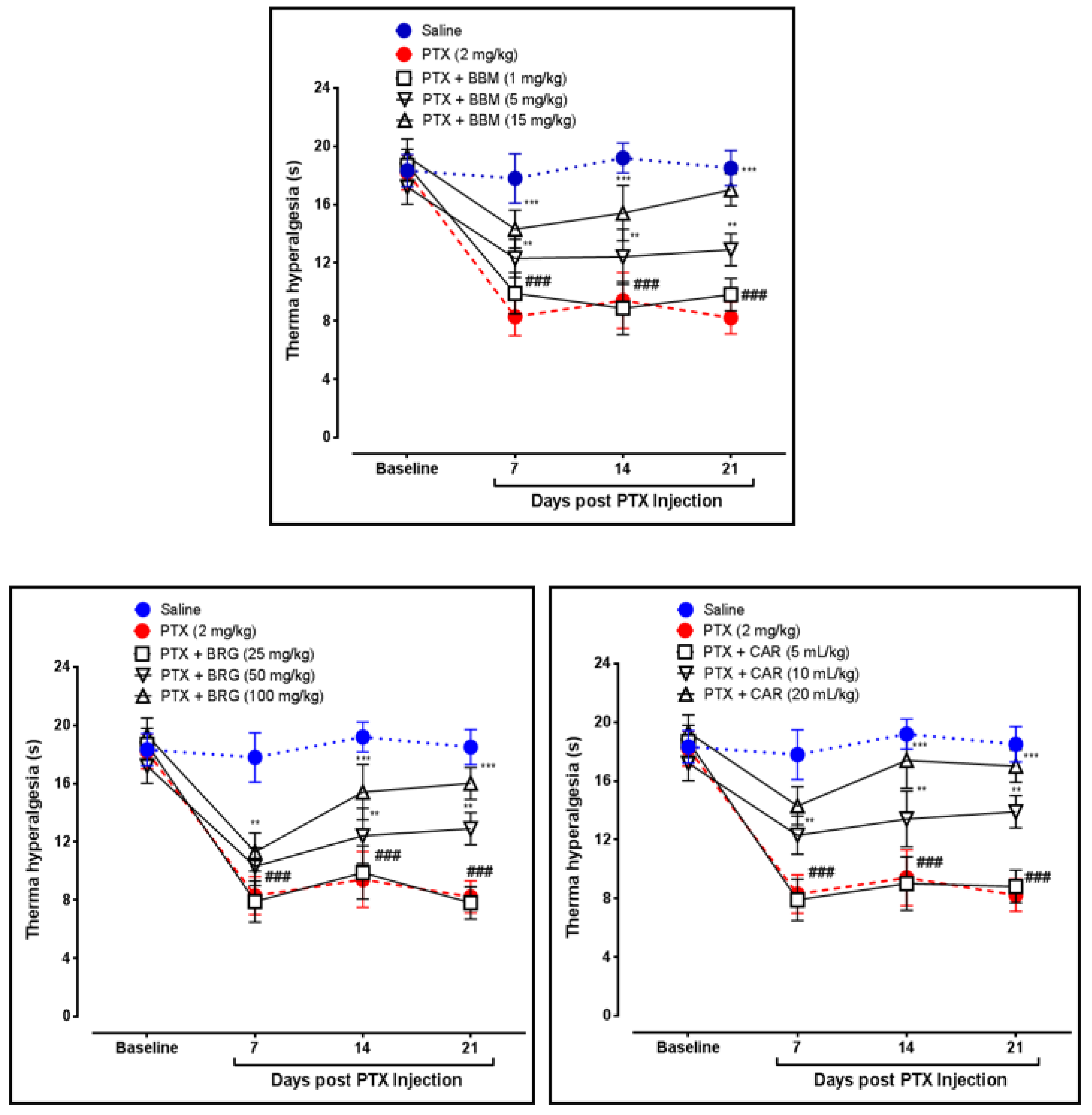
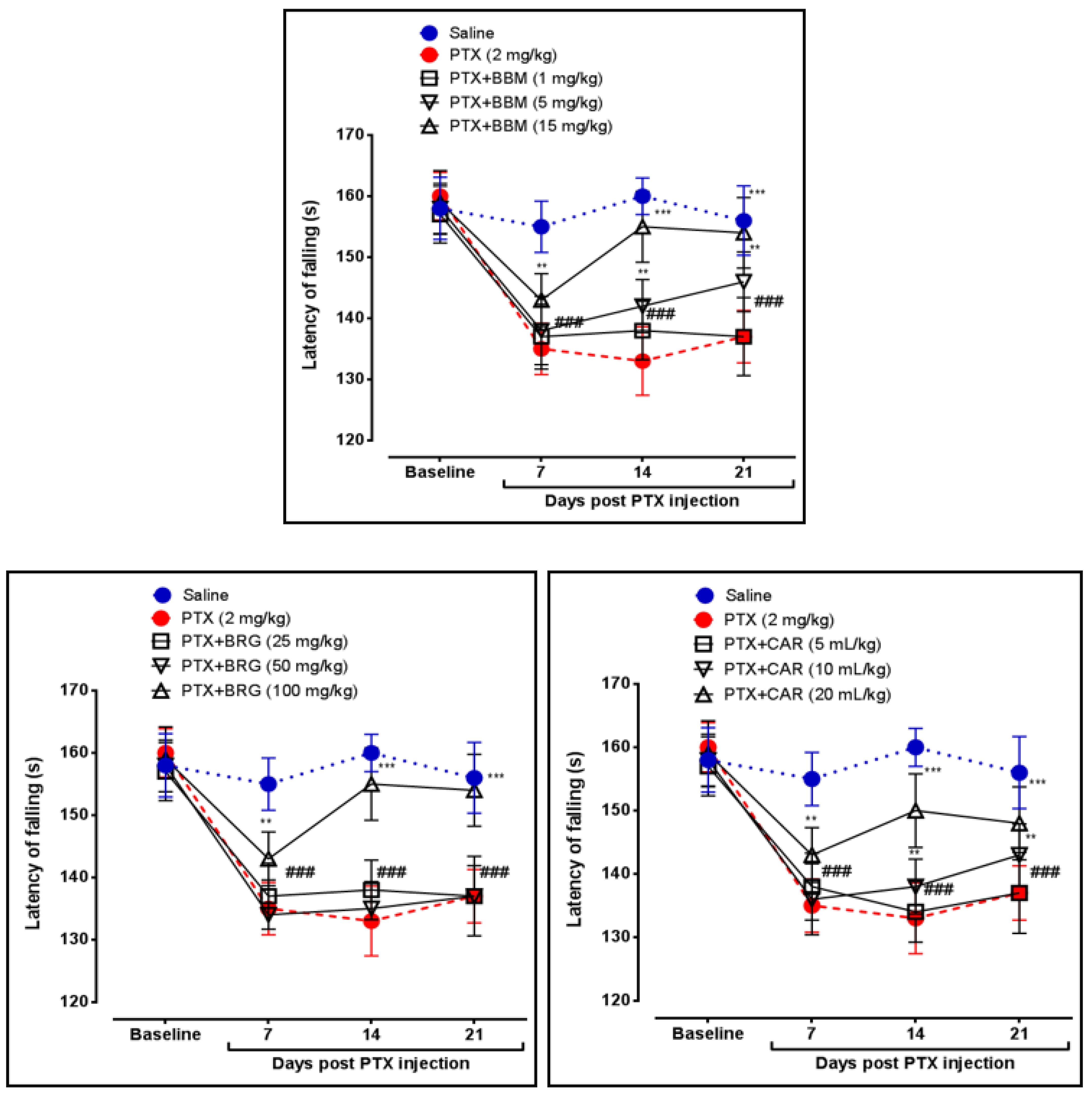
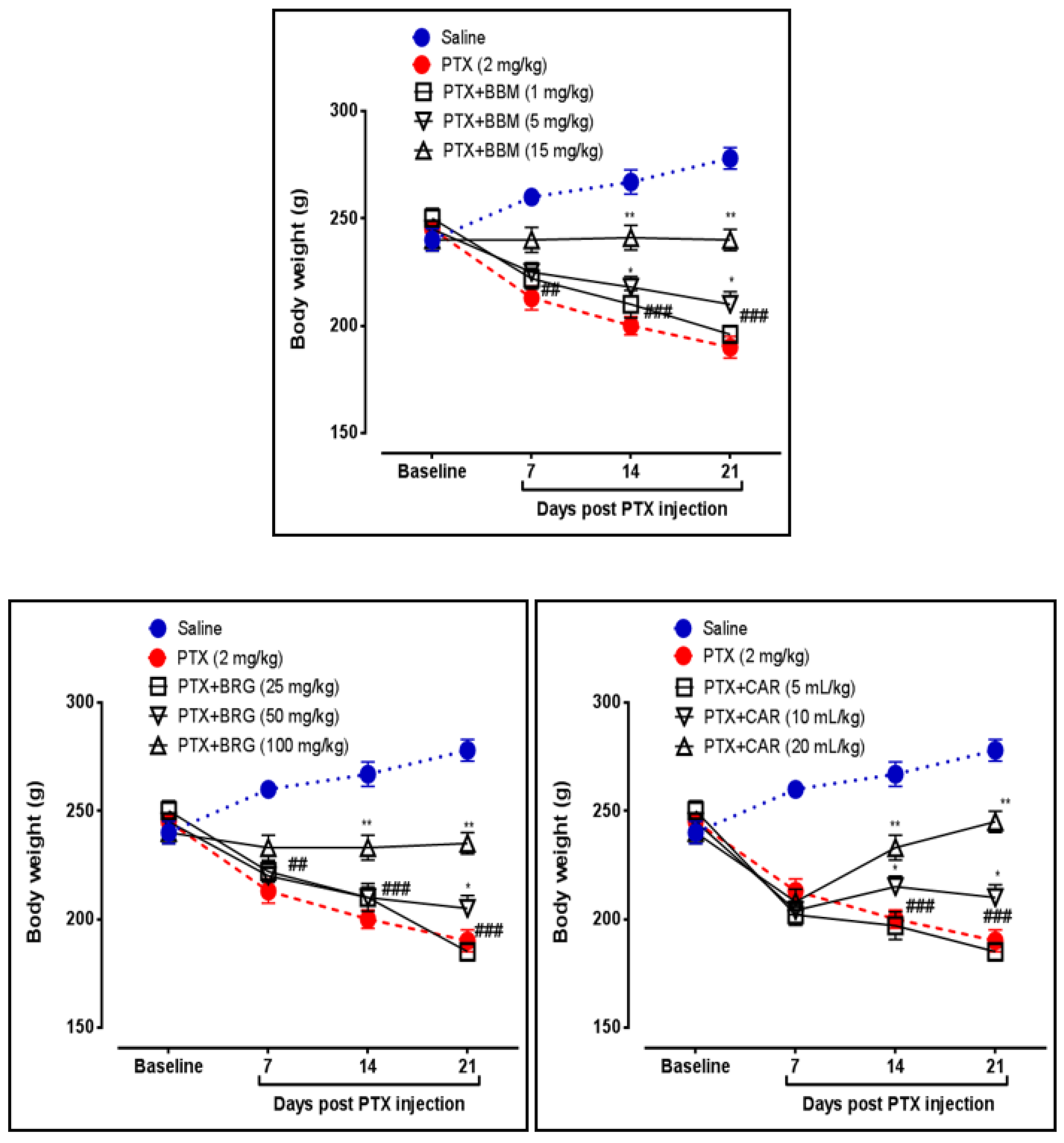

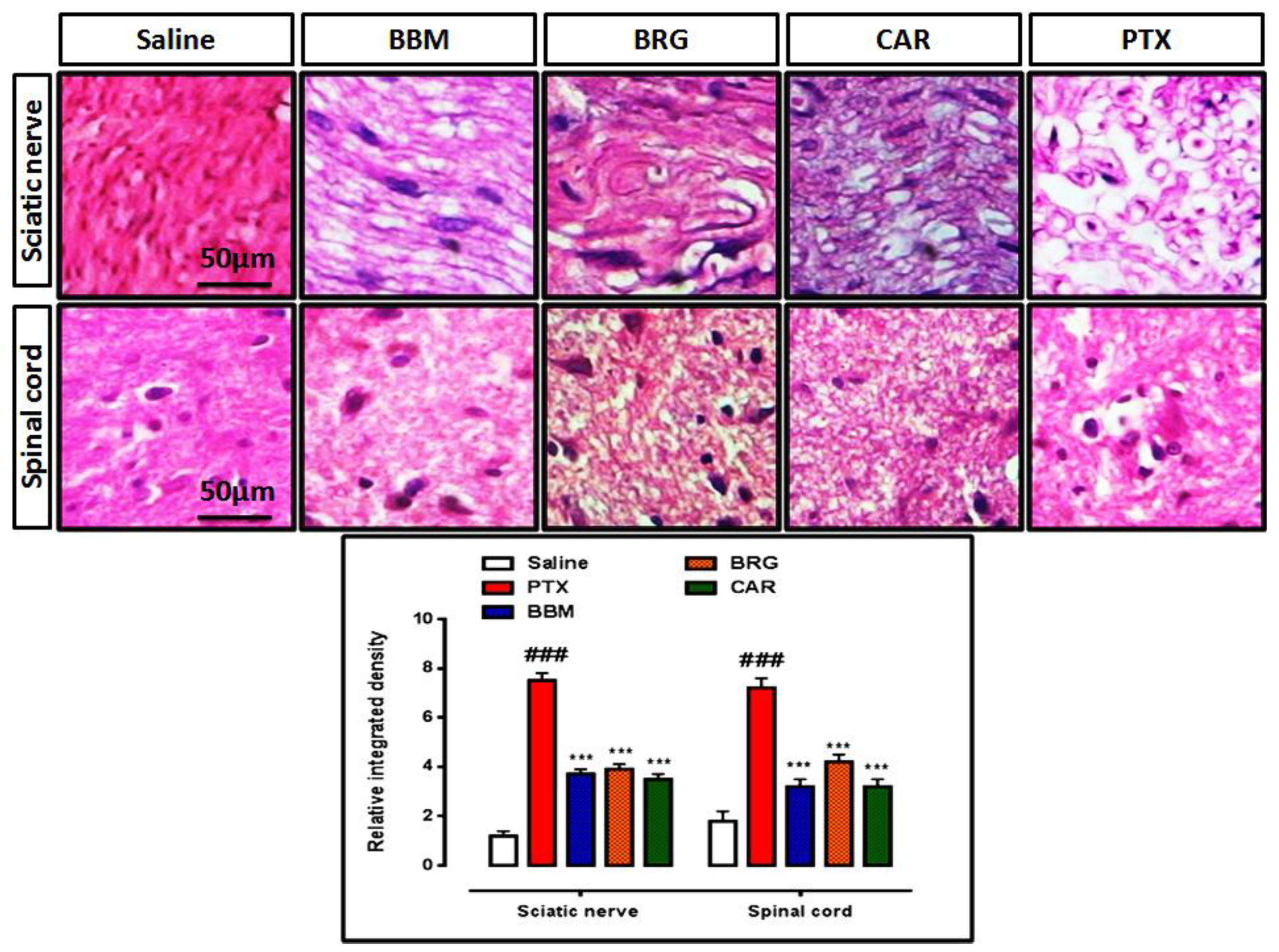
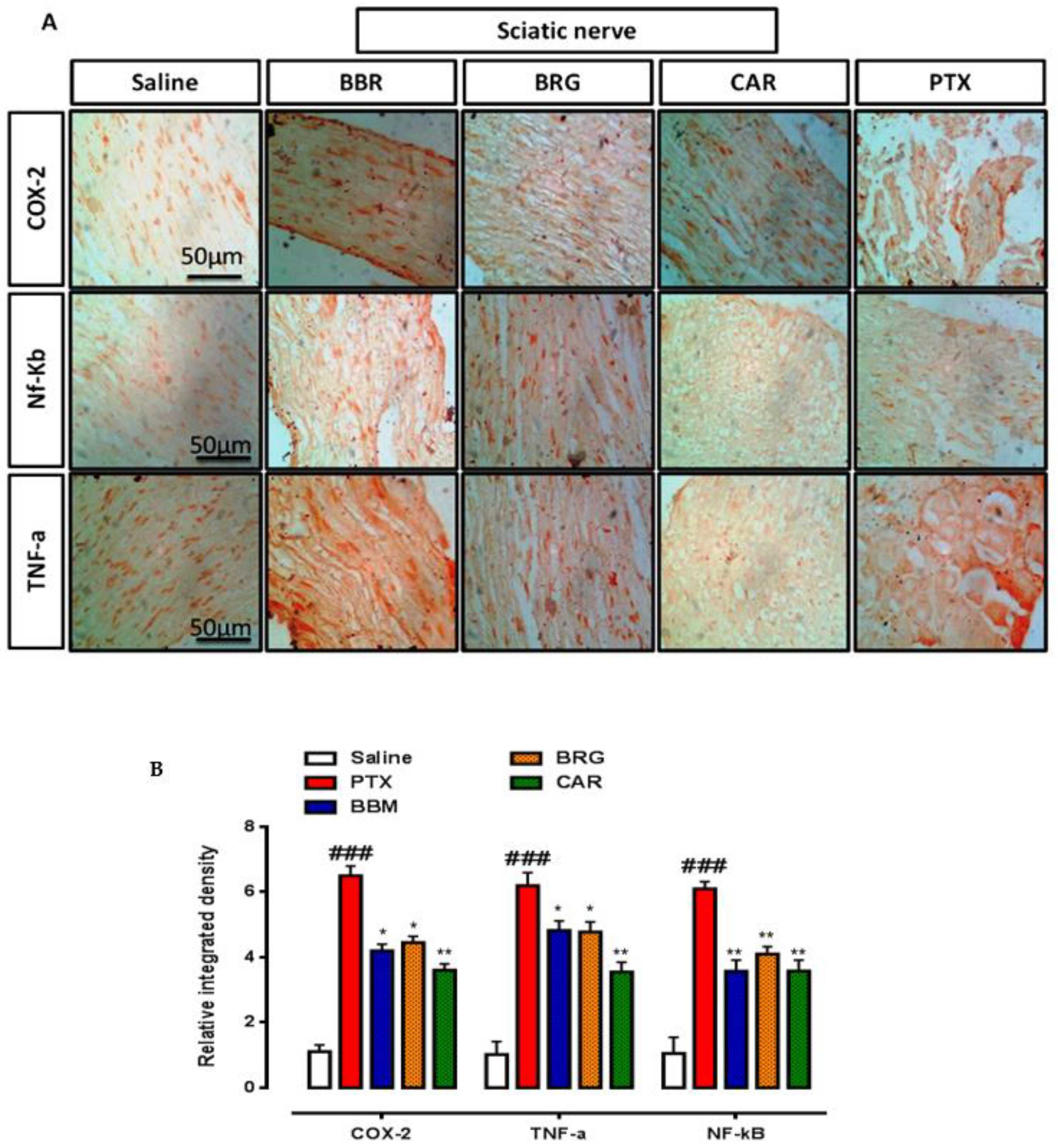

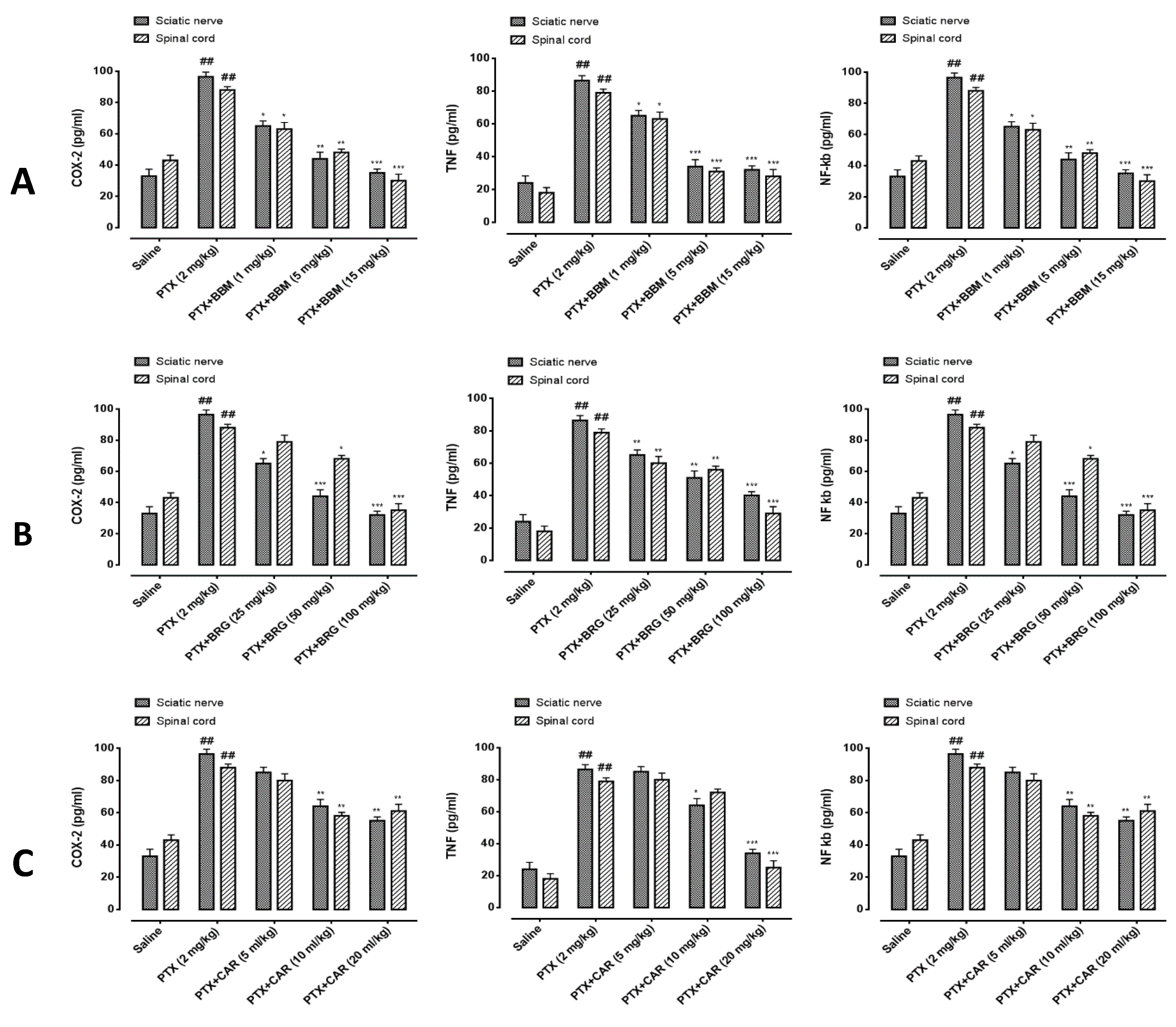
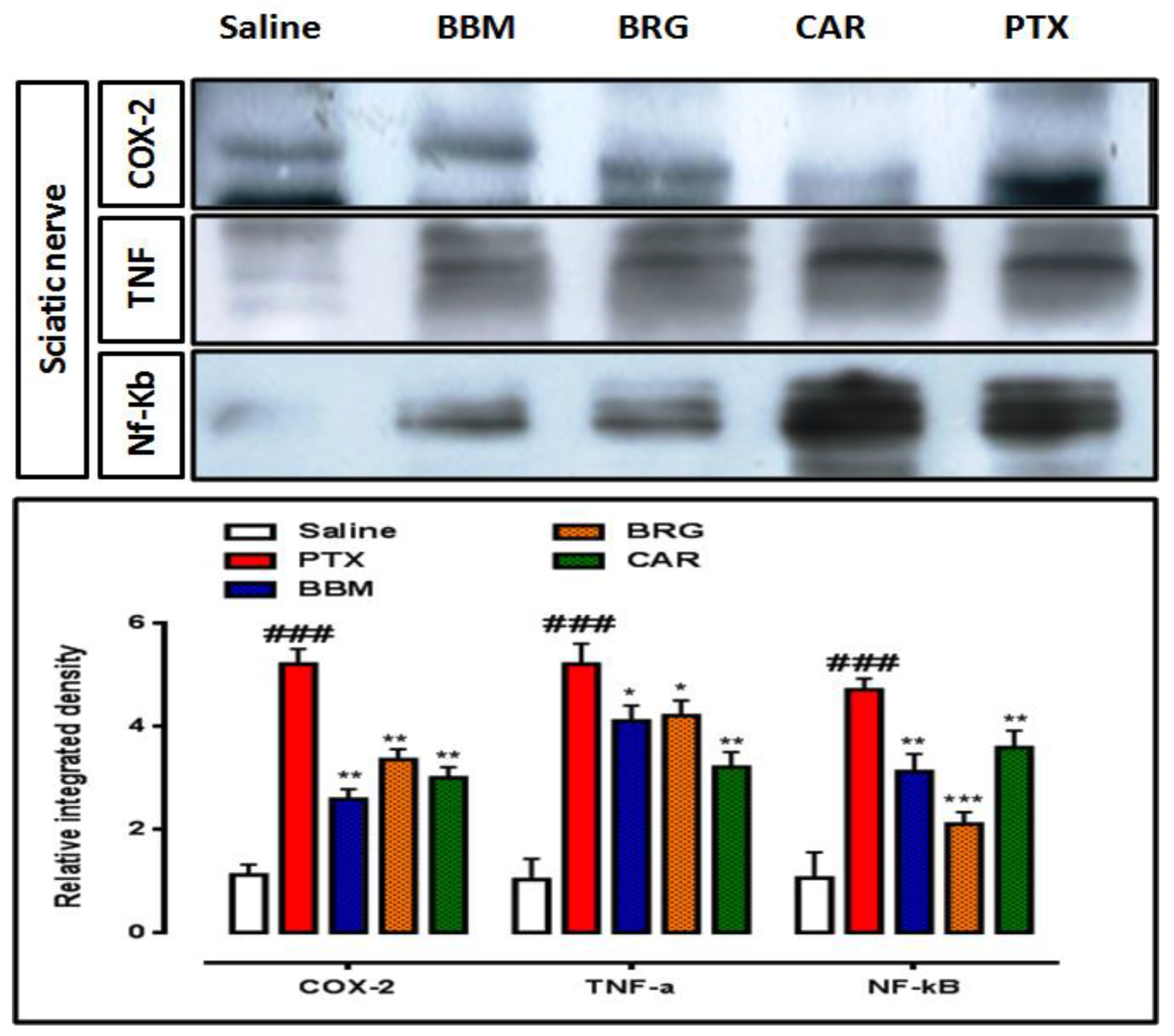
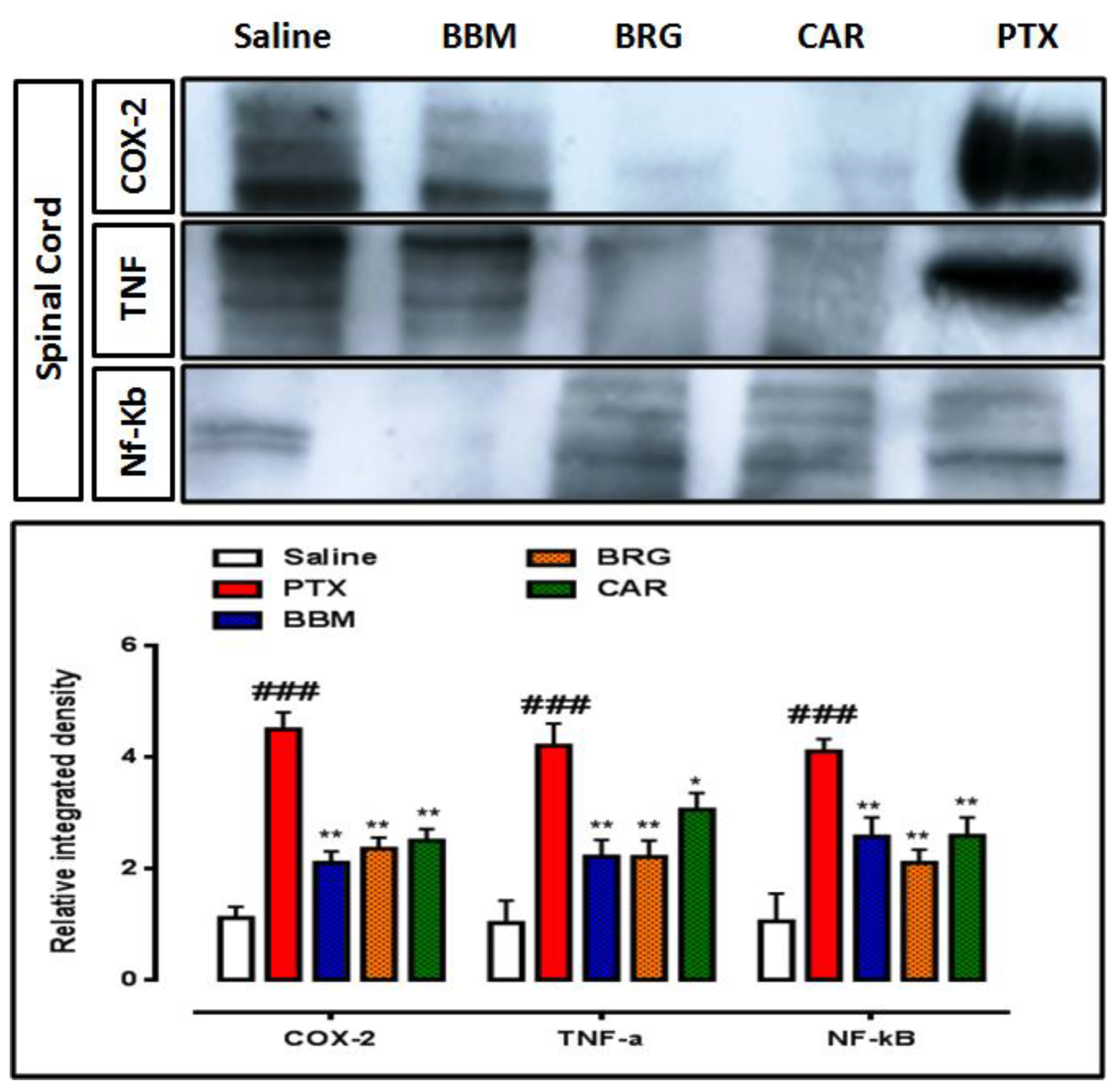
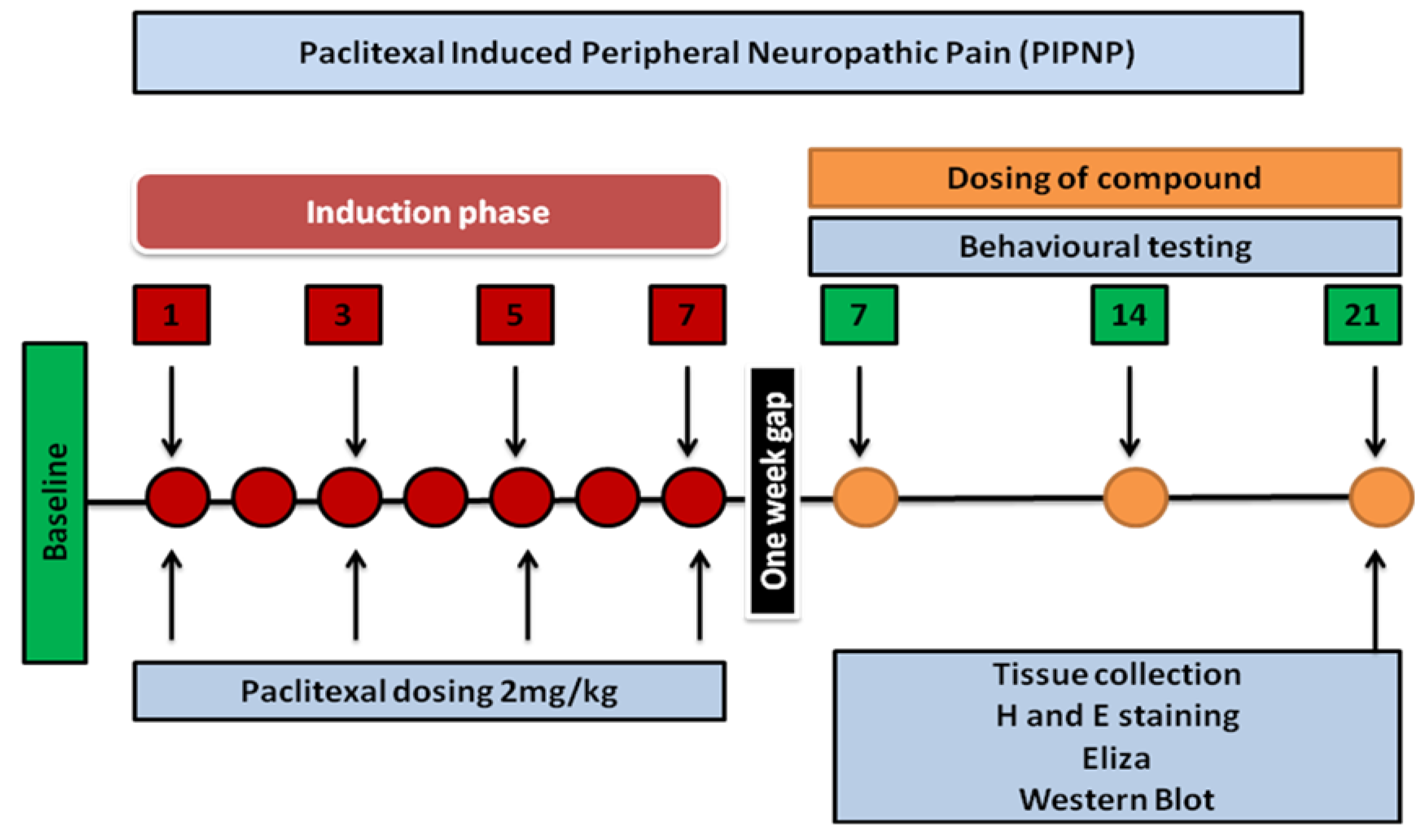
| Group | GSH (µmol/mg of Protein) | GST (µmol CDNB Conjugate/min/mg of Protein) | iNOS (µmol/mg of Protein) | LPO (nmol/TBARS/mg of Protein) |
|---|---|---|---|---|
| Saline (10 mL/kg) | 48.22 ± 2.1 | 43.88 ± 1.5 | 34.22 ± 3.1 | 62.43 ± 1.8 |
| PTX (2 mg/kg) | 7.22 ± 1.7 ### | 10.53 ± 2.6 ### | 105.32 ± 3.2 ### | 286.66 ± 2.2 ### |
| PTX+BBM (15 mg/kg) | 30.29 ± 2.2 ** | 36.10 ± 3.4 ** | 66.21 ± 1.6 * | 112.36 ± 2.8 * |
| PTX+BRG (100 mg/kg) | 24.24 ± 2.2 ** | 29.14 ± 2.4 ** | 78.11 ± 2.2 * | 128.10 ± 1.8 * |
| PTX+CAR (20 mL/kg) | 28.14 ± 1.2 ** | 33.50 ± 1.4 ** | 56.11 ± 2.6 * | 132.16 ± 3.8 * |
| Group | GSH (µmol/mg of Protein) | GST (µmol CDNB Conjugate/min/mg of Protein) | iNOS (µmol/mg of Protein) | LPO (nmol/TBARS/mg of Protein) |
|---|---|---|---|---|
| Saline (10 mL/kg) | 43.22 ± 1.8 | 35.71 ± 2.1 | 41.35 ± 1.2 | 62.33 ± 1.3 |
| PTX (2 mg/kg) | 9.41 ± 1.5 ### | 7.53 ± 3.4 ### | 98.32 ± 2.3 ### | 195.68 ± 1.6 ### |
| PTX+BBM (15 mg/kg) | 33.21 ± 1.4 ** | 26.14 ± 3.2 ** | 52.41 ± 2.5 ** | 76.66 ± 1.0 ** |
| PTX+BRG (100 mg/kg) | 25.21 ± 2.6 ** | 26.12 ± 3.2 ** | 73.41 ± 1.5 ** | 113.22 ± 1.8 *** |
| PTX+CAR (20 mL/kg) | 29.14 ± 0.6 ** | 22.22 ± 1.2 ** | 63.11 ± 1.5 ** | 103.36 ± 2.0 *** |
Publisher’s Note: MDPI stays neutral with regard to jurisdictional claims in published maps and institutional affiliations. |
© 2022 by the authors. Licensee MDPI, Basel, Switzerland. This article is an open access article distributed under the terms and conditions of the Creative Commons Attribution (CC BY) license (https://creativecommons.org/licenses/by/4.0/).
Share and Cite
Faheem, M.; Khan, A.-u.; Saleem, M.W.; Shah, F.A.; Ali, F.; Khan, A.W.; Li, S. Neuroprotective Effect of Natural Compounds in Paclitaxel-Induced Chronic Inflammatory Pain. Molecules 2022, 27, 4926. https://doi.org/10.3390/molecules27154926
Faheem M, Khan A-u, Saleem MW, Shah FA, Ali F, Khan AW, Li S. Neuroprotective Effect of Natural Compounds in Paclitaxel-Induced Chronic Inflammatory Pain. Molecules. 2022; 27(15):4926. https://doi.org/10.3390/molecules27154926
Chicago/Turabian StyleFaheem, Muhammad, Arif-ullah Khan, Muhammad Waqas Saleem, Fawad Ali Shah, Fawad Ali, Abdul Waheed Khan, and Shupeng Li. 2022. "Neuroprotective Effect of Natural Compounds in Paclitaxel-Induced Chronic Inflammatory Pain" Molecules 27, no. 15: 4926. https://doi.org/10.3390/molecules27154926
APA StyleFaheem, M., Khan, A.-u., Saleem, M. W., Shah, F. A., Ali, F., Khan, A. W., & Li, S. (2022). Neuroprotective Effect of Natural Compounds in Paclitaxel-Induced Chronic Inflammatory Pain. Molecules, 27(15), 4926. https://doi.org/10.3390/molecules27154926






